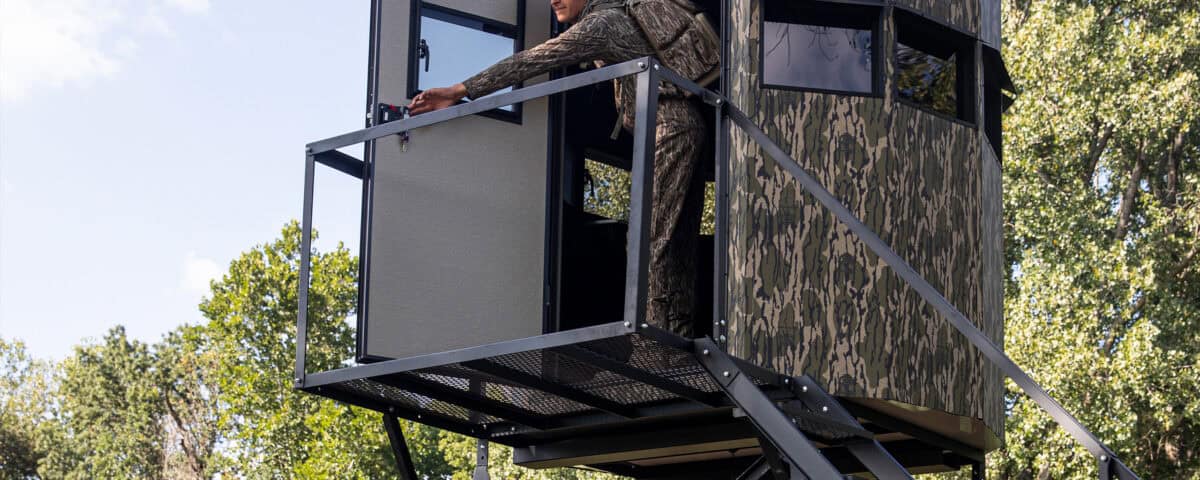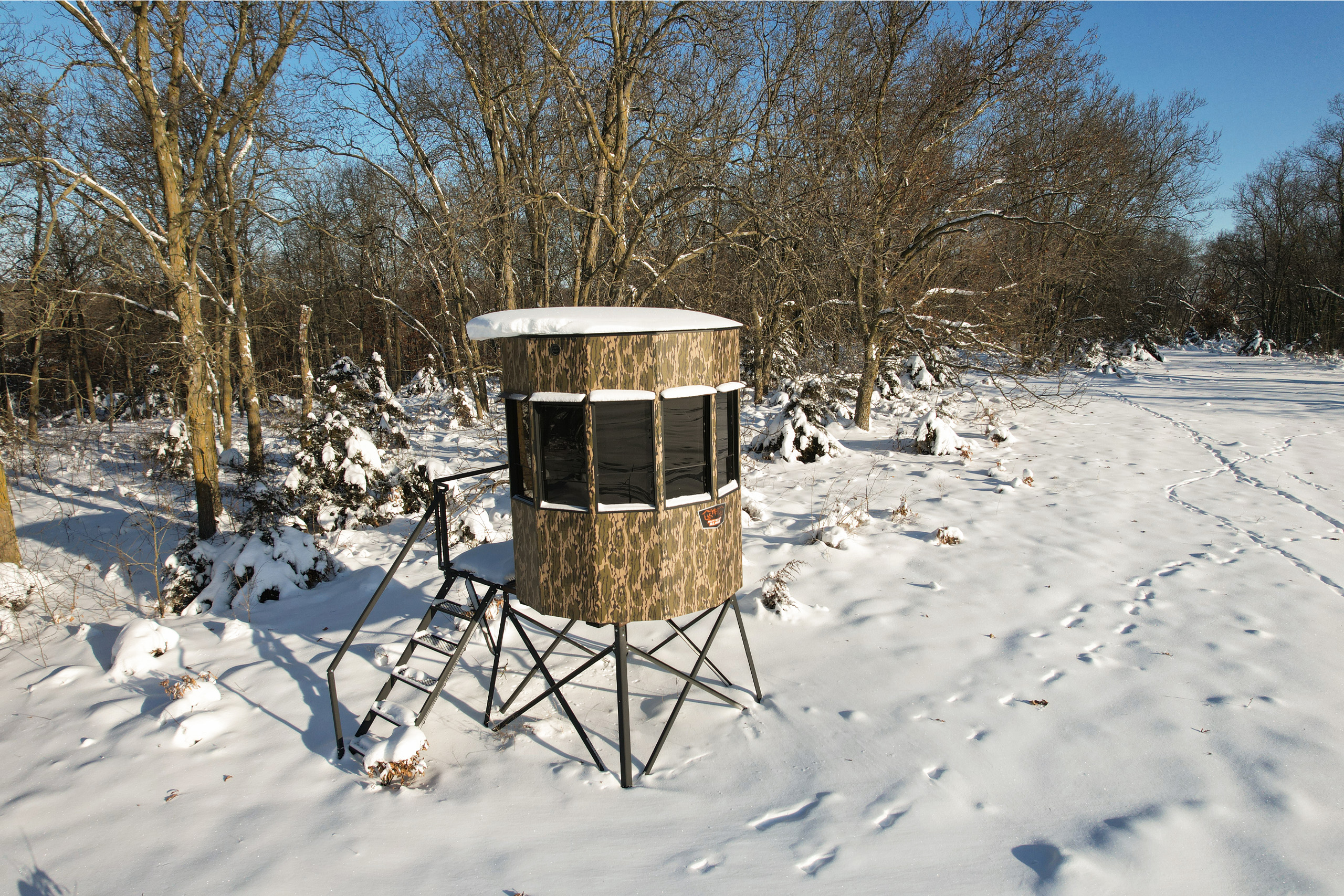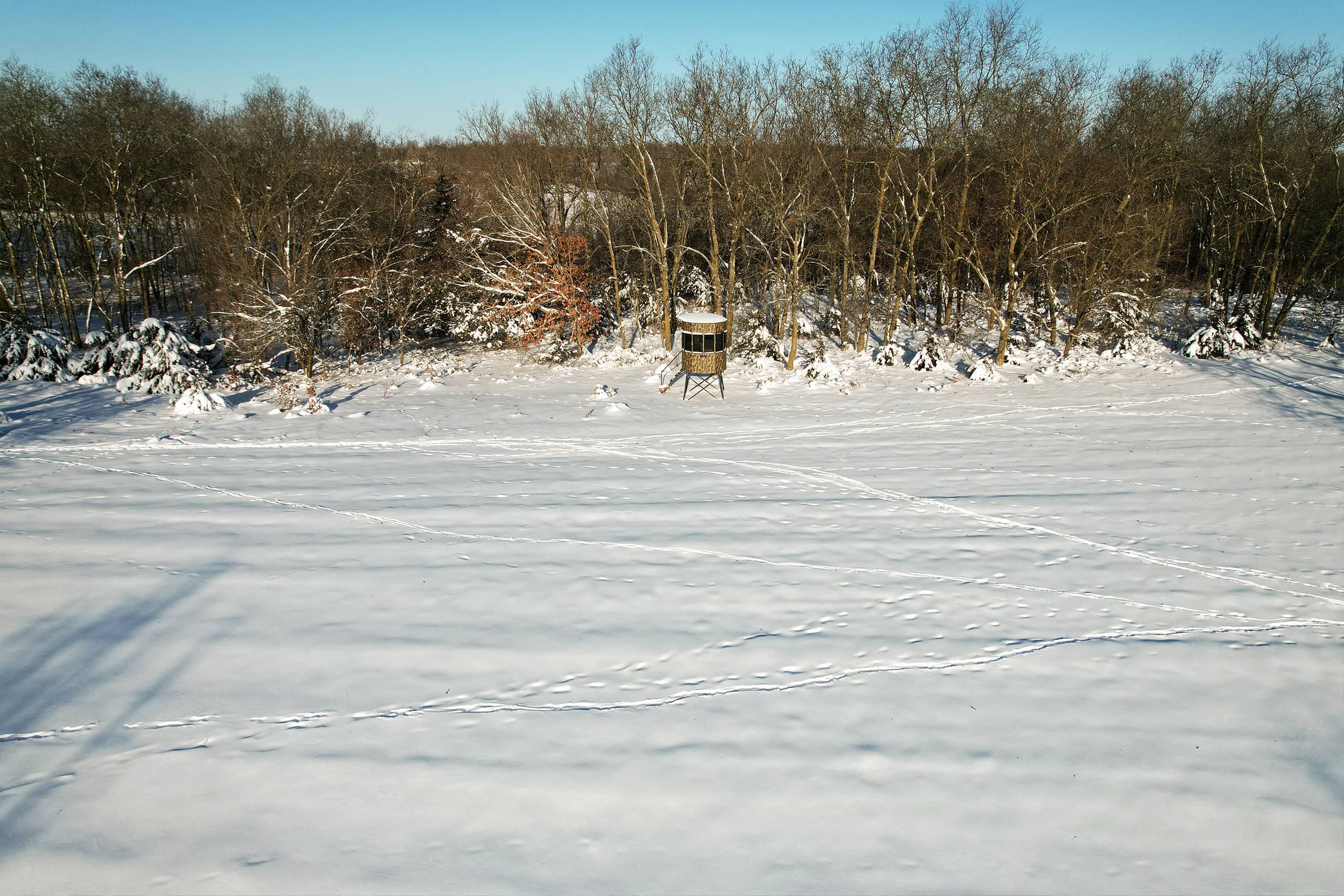Introduction to Scent Control for Bowhunting
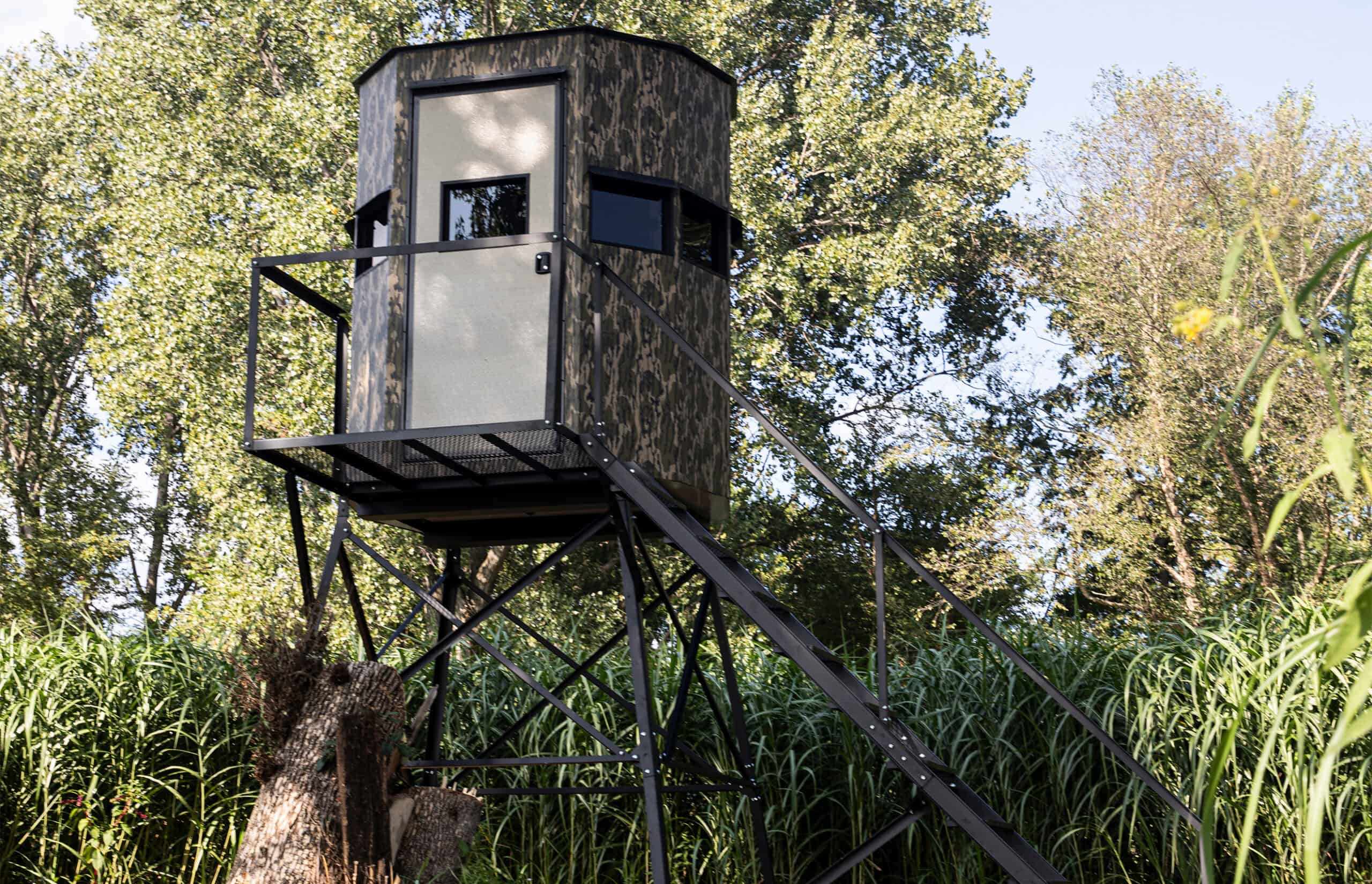
Top Reasons to Use an Elevated Hunting Blind This Season
October 8, 2024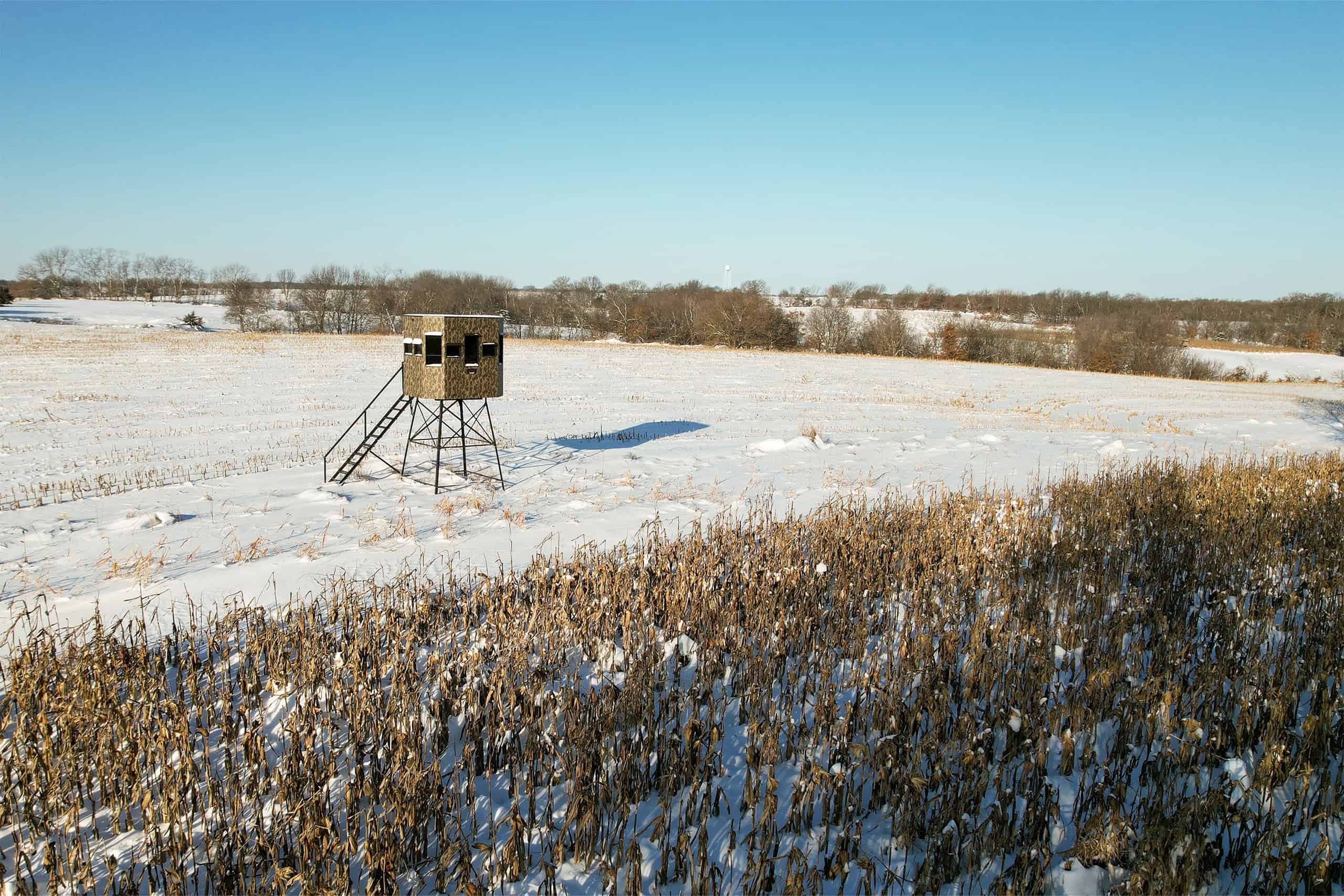
Hunting and Frostbite
October 24, 2024Bowhunting requires hunters to get up close and personal with their game, often within 20 to 30 yards of a target. While this offers a thrilling experience, it also means that every move—and every scent—matters. Whitetail deer, in particular, have an extraordinary sense of smell, allowing them to detect human scent from hundreds of yards away. For this reason, scent control is one of the most critical aspects of successful bowhunting.
In this blog, we’ll walk through the various scent control strategies available, from using odor-eliminating sprays and ozone generators to understanding how wind direction can make or break a hunt. We’ll also highlight how Rutted-Up Blinds can give bowhunters the upper hand by providing airtight protection to help keep your scent contained. Let’s dive into why scent control is so important and the tools you can use to stay undetected.
Why Scent Control is Critical for Bowhunters
For bowhunters, getting close to a target is essential, but the closer you get, the more your chances of being detected by a deer’s sharp sense of smell increase. Deer rely heavily on their noses to detect danger, while sight is secondary: stalking them from downwind may leave them standing there staring blankly at your camo as you finish your approach. But a deer’s sense of smell is incredibly effective in detecting threats, and even the faintest whiff of human scent can send them running, leaving you coming home to tell your wife about the deer you almost shot. Unlike long-range rifle hunters, bowhunters don’t have the luxury of maintaining distance, making scent control crucial to remaining undetected.
Proper scent control can be the difference between a deer coming within range or bolting, tail flag waving, as soon as they catch your scent. Bowhunters must take meticulous care to keep deer from detecting them, and the easiest way for a deer to do that is typically by smell. While you can never be 100% scent-free in the open (even your breath will carry an odor), using a combination of tactics—from odor-eliminating sprays and ozone generators to hunting downwind and airtight blinds like Rutted-Up Blinds—can greatly reduce the chances of detection and buy you the crucial time needed to make the perfect shot.
Using Odor-Eliminating Sprays
Odor-eliminating sprays are one of the most common and accessible tools for controlling scent while bowhunting. These sprays claim to work by targeting and neutralizing odor-causing bacteria and chemicals on your skin, clothing, and gear. The sprays typically contain antimicrobial agents that break down or mask human scent molecules, making it harder (in theory, at least) for deer to detect you.
How to Use Odor-Eliminating Sprays:
- Pre-Hunt Application: Spray down your hunting clothes and gear before heading out. You may as well go all-in: cover every layer of clothing, including base layers, outerwear, and especially high-contact areas like boots, gloves, and hats.
- Mid-Hunt Touch-Ups: If you’re out for an extended period or if you’ve exerted yourself physically (AKA, you’re sweaty), try reapplying the spray. Keep a bottle in your pack for touch-ups throughout the day.
- Boot Care: Your boots can leave a scent trail behind as you walk to your hunting spot. Spraying the soles and sides of your boots before entering the woods may help mask your presence and prevent game from detecting you along the trail.
While odor-eliminating sprays are not a complete solution on their own, they may play an important role in reducing your overall scent profile. When combined with other scent control measures, such as hunting with the wind in your favor and using airtight blinds like Rutted-Up Blinds, they become a weapon in your scent-controlling arsenal for staying undetected.
Ozone Generators
Ozone generators have become increasingly popular among hunters for their effectiveness in neutralizing scent. These devices work by emitting ozone (O3) particles, which bond with and destroy odor-causing molecules. There’s no need to get into the chemistry of it because the practical result is simple and noticeable even to a human’s sense of smell: these devices help reduce or eliminate human scent, making it much harder for deer to detect your presence.
How to Use Ozone Generators:
- Pre-Hunt Clothing Treatment: One of the typical uses of ozone generators is to treat your hunting clothes before heading out. By placing your gear in an airtight container or bag along with a portable ozone generator, you can remove odors from your clothes, boots, and gear.
- In-Field Application: Some hunters use portable ozone generators in the field, setting them up in their blind (not recommended) or near their stand. These devices continue to emit ozone while you hunt, hopefully working to neutralize any scent you may give off during the day.
While ozone generators can be effective for scent control, particularly with your clothes, it’s important to note that breathing in concentrated ozone can be harmful to your health. It works to kill scent, but it also works to kill you (in high enough doses, anyway). Always follow the manufacturer’s guidelines and ensure adequate ventilation when using ozone devices in enclosed spaces to minimize exposure.
Scent-Free Soaps and Hygiene for the Hunt
Your personal hygiene can play a crucial role in reducing scent while bowhunting. Every part of your body—especially areas that generate heat, like your head, armpits, and sweaty feet—produces human odors that deer can detect. Using scent-free hygiene products helps eliminate these odors at their source, reducing the overall amount of scent you carry into the woods.
Key Hygiene Practices for Scent Control:
- Scent-Free Shower: Before heading out, take a shower using scent-free soap and shampoo designed for hunters. These products are designed to remove natural body oils and odors without leaving behind any fragrances that could alert game.
- Scent-Free Antiperspirant: Apply a scent-free antiperspirant to reduce the amount of sweat (and therefore odor) your body produces during the hunt. Even when sitting still, your body releases scent, so it’s important to keep sweat and body odor in check.
- Oral Hygiene: Believe it or not, your breath is a source of scent. Brushing your teeth with scent-free toothpaste or chewing odor-neutralizing gum (such as gum with chlorophyll) may help reduce odors from your mouth.
Post-Shower Strategy: After your shower, dress in freshly laundered (with scent-free detergent), scent-free clothes stored in an airtight container. If you have your ozone generator, run the clothes through there for good measure. This prevents your clothes from picking up any odors from your home, car, or surroundings. When you arrive at your hunting location, change into your hunting gear to minimize contamination from car exhaust or other common odors.
Understanding Wind Direction: The Most Important Scent Control Tactic
Even with the best scent-eliminating products, the single most important factor in scent control is wind direction. Whitetail deer rely heavily on their noses to detect danger, and their ability to scent-check their environment makes hunting the wind your most powerful tool for staying undetected.
Why Wind Direction Matters: Wind carries scent particles through the air, spreading them in a “V” shape downwind from your location. If you’re not mindful of the wind, your scent could be carried directly into a deer’s path, ruining your chance for a shot. By positioning yourself downwind of where you expect deer to travel, you can avoid alerting them to your presence–in fact, deer may walk within feet of you without realizing it. Smell is the deer’s most important sense for detecting danger, but if the wind is against them, it can become useless and allow you to take a shot on a completely unsuspecting deer.
How to Use Wind to Your Advantage:
- Pre-Hunt Planning: Before heading out, check the forecast to see how the wind is expected to behave throughout the day. Some hunting apps now feature wind maps that help you identify the optimal spots to place your blind or stand.
- Adjust Your Approach: When walking to your hunting location, make sure you approach from downwind, keeping your scent away from deer bedding or feeding areas. This minimizes the chances of leaving a scent trail that could alert game to your presence.
- Rutted-Up Blinds and Wind Strategy: The airtight nature of Rutted-Up Blinds helps contain your scent once inside, but the wind is still crucial during entry and exit. Positioning your blind in a location that works with the wind ensures that even if some scent escapes, it won’t be carried toward game.
While scent-control products and airtight blinds can significantly reduce your scent signature, understanding and utilizing wind direction is your best defense against being detected when out in the open. Always hunt with the wind in mind if you are out in the open. We all know those hunters (or have heard of them) who sit out with a cigarette and a steaming cup of coffee and still shoot a massive buck. You can be sure they were downwind of those deer, or there was no wind at all when that happened. But these stories, though they may be exaggerated, still show the efficacy of hunting the wind.
Rutted-Up Blinds: Airtight Design for Superior Scent Containment
There is a another strategy: stay inside an airtight blind. One of the standout features of Rutted-Up Blinds is their airtight design, which plays a crucial role in scent control during bowhunting. Unlike traditional open stands or ground blinds, Rutted-Up Blinds are specifically engineered to contain your scent, keeping it from spreading into the surrounding environment and alerting game.
The airtight seals around windows and doors help human odors stay inside the blind, offering a significant advantage for close-range bowhunters. This design works particularly well when combined with other scent control tactics, such as using odor-neutralizing sprays and ozone generators inside the blind. By keeping your scent confined, Rutted-Up Blinds reduce the likelihood of deer detecting you, even if they come from downwind of you. With Rutted-Up Blinds, bowhunters gain a crucial edge by controlling their scent in an effective, stealthy way.
The Role of Scent-Free Clothing and Gear
Wearing scent-free clothing and using gear designed to minimize odor is another important step in a comprehensive scent control strategy. Clothing, especially base layers and outerwear, can absorb and carry scent into the field, so it can be helpful to use materials that help reduce or neutralize odor.
How to Minimize Scent on Your Approach to the Blind
Even with the best scent control gear and airtight blinds, one of the most vulnerable times for hunters is during the approach to the hunting spot. Walking through grass, brush, or disturbed ground can leave a scent trail that deer will detect long after you’ve passed through. For bowhunters who need to get close to their target, minimizing scent during your approach is a smart move.
Steps to Minimize Scent During Your Approach:
- Plan Your Route: Try to approach your hunting blind or stand from downwind direction of where you expect the deer to be. This prevents your scent from drifting toward bedding areas or trails where deer are likely to be. Use natural barriers like creeks or fields to reduce contact with vegetation.
- Walk Slowly and Deliberately: Avoid sweating during your approach, as sweat is a major source of human odor. Take a slow, deliberate walk to your blind, which will not only keep your scent under control but also reduce noise that might alert game.
- Use Scent-Free (or at Least Less Smelly) Boots: Your boots can carry odors from your home or vehicle into the field. Clean them with scent-eliminating products and, if possible, use rubber boots, which are less likely to absorb and transfer odors. Tuck your pants into your boots while you’re at it; this can help to leave less ground scent as you walk. Some hunters even spray a cover scent, such as a natural earth scent, on their boots to mask their trail.
By carefully managing your scent on the way to the blind, you may reduce the chances of spooking deer before you even get into position. We say “may help”, because so far, no one has successfully figured out how to interview a deer and ask them what products work best.
Final Thoughts: Combining Scent Control Techniques for Bowhunting Success
Scent control is one of the most important factors in successful bowhunting, where getting close to your target is essential. No single tactic can completely eliminate your scent, but paying attention to the most important strategies can significantly reduce or eliminate the smell that travels to the deer and improve your chances of staying undetected.
From using odor-eliminating sprays and ozone generators to wearing scent-free clothing and understanding wind direction, each step you take adds up. Rutted-Up Blinds, with their airtight design, offer an additional layer of protection by keeping your scent contained and minimizing the chances of detection.
When you combine these techniques—pre-hunt hygiene, scent-free clothing and gear, scent control during your approach, and hunting from an airtight blind—you give yourself the best can matter, and by implementing these strategies, you’ll maximize your opportunity to stay concealed and bring game within range.
Ready to elevate your hunting game?
Rutted-Up Blinds provide airtight, scent-containment solutions designed to keep you concealed and comfortable, no matter the conditions. Explore our range of durable, high-performance hunting blinds today and take your scent control strategy to the next level. Visit Rutted-Up Blinds now to gear up for your most successful hunt yet!

